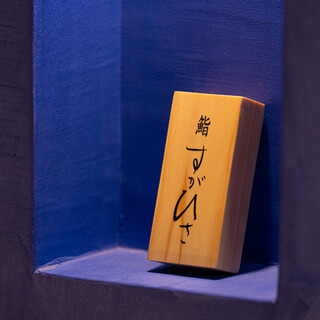
鮨 すがひさ
Sushi Sugahisa
3.66
Tameike–Sanno, Kasumigaseki
「Sushi」
20,000-29,999円
3,000-3,999円
Opening hours: Tuesday, Wednesday, Thursday, Friday
11:00 - 14:00
18:00 - 19:45
20:00 - 22:00
Saturday, Sunday, Holidays
12:00 - 14:00
17:00 - 18:45
19:00 - 21:00
Mon.
Closed
Rest time: Business hours[Tue-Fri]LunchChirashi-zushi ends when all the sushi is gone11:00~14:00If there are reservations, they will be given priority.
東京都港区虎ノ門2-7 虎ノ門ヒルズ ステーションタワー 4F
Photos
(20)
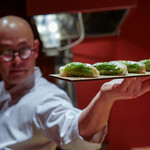
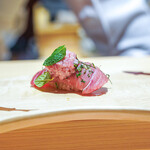

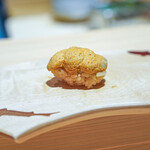
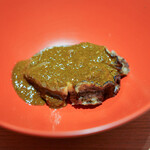
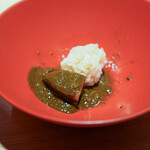

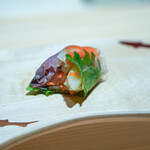
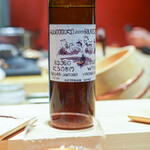
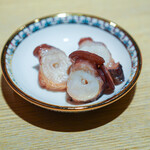
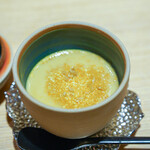

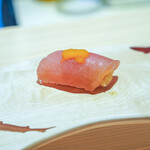
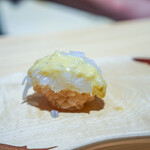
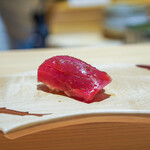
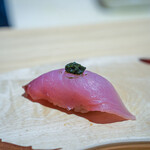

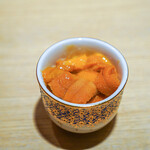
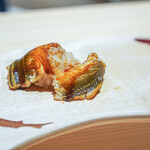
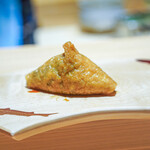
Details
Reservation Info
Reservations are required. Please call us for private parties.
Children
child-friendly
Payment Method
Credit cards accepted
(VISA, Master, JCB, AMEX, Diners)
Electronic money accepted (transportation system electronic money (Suica, etc.), iD, QUICPay)
QR code payment accepted
(PayPay, d-payment, Rakuten Pay, au PAY)
Restaurant Service Fee
10% service charge
This fee is charged by the restaurant, not related to our platform
Number of Seats
6 seats
(Counter only)
Private Dining Rooms
None
Smoking and Non-Smoking
No smoking at the table
Parking
having
Facilities
Stylish space, calm space, counter seating available.
Drink
Sake available, shochu available, wine available, stick to sake, stick to shochu, stick to wine
Dishes
Focus on fish dishes
Comments
(21)
驢馬人
4.20
"Sushi Sugahisa" @ Toranomon Hills (☆彡)
The unique sushi from "Sushi Sugahisa," which was previously available only at events in Mizonokuchi, has now made its debut at Toranomon Hills! The fusion of spicy Thai cuisine and sushi is truly impressive. The chef, hailing from the Thai dish "Im Yum," offers an entirely new sushi experience that is now accessible to those who haven’t tasted it before.
Address: 2-7 Toranomon, Minato-ku, Toranomon Hills Station Tower 4F
Phone: None
Closed: Mondays
Hours: 11:00 AM - 2:00 PM (Weekends: 12:00 PM - 2:00 PM) / 5:30 PM - 7:00 PM / 8:00 PM - 10:00 PM
The entrance to "Sushi Sugahisa" is through a blue door in the back left of the blue wall labeled "Sushi Onikai x2." The door has a wooden sign next to it. It's a push door, so you just need to push to enter. Inside, the walls are red with geometric patterns, and you are greeted by a sushi counter right after a short corridor. The wall-side features glass up to the high ceiling, offering a view of Tokyo Tower.
On the night of February 23, 2024, I visited at 5:30 PM after reserving through TableCheck. The automated door of "Onikai x2" doesn’t open early, so I waited until just before my reservation to enter.
I opted for the "Thai Cuisine x Sushi Omakase Course" priced at 23,000 yen. I started with cold roasted green tea. The strong aroma of spices being cooked in front of me was quite noticeable, but it was soon overshadowed by the scent of perfume from a woman who entered later. Thankfully, that settled down after a bit.
The first dish was fresh oysters topped with a kiwi and coconut milk mint paste. The back had another paste made with kiwi, coconut milk, cilantro, and fish sauce. The sharp acidity I anticipated from the aroma was subdued. The strong flavor of the oysters held up well against the spices.
Next was tender braised abalone, coated in a rich green sauce made from oyster sauce, a herb called kachai, and a red curry liver sauce. After enjoying the abalone, they added red vinegar sushi rice into the leftover sauce. The firm sushi rice surprisingly masked the vinegar’s acidity, blending harmoniously as a curry.
Then came mackerel marinated in vinegared rice paper rolls, rolled with daikon, carrot, and shiso. As usual, this was delicious! It seemed to lack white sesame, but maybe it was intentionally omitted.
The octopus, simmered in a mixture of sugar, fish sauce, and cardamom, was served in chunks. I felt it could have used a bit more salt. The chef’s knife had a design inspired by Thai cuisine. The black cutting board was a modern resin material, making it easy to clean and manage.
Next up was a custard made with fugu (pufferfish) milt, served in a lid-covered dish. Opening the lid revealed a wonderful aroma. It was topped with green curry, and it was incredibly tasty—hot, creamy, and well-balanced. I would love to have this again.
The sweet shrimp marinated in Shaoxing wine was exceptional, soaked in a sauce made from Thai seasonings, Shaoxing wine, and kaffir lime leaves. The fresh shrimp had an intense ethnic aroma, making it delicious.
We then transitioned to nigiri sushi starting with pickled ginger, a mix of ginger and green papaya pickled in sweet vinegar and lime, sprinkled with dill. The crunchy texture was wonderful.
The first nigiri was sea bream, topped with fish sauce, lime, cilantro, mint, and garlic paste. The mint was a refreshing innovation. The red vinegar sushi rice was quite firm and sticky.
Next was Skipjack tuna from Katsuura, topped with a paste of mango and green chili. The natural sweetness of the mango was complemented by the spicy kick that followed. The Skipjack tuna itself was light in flavor.
Then I enjoyed warm jasmine tea served in a lightweight wooden cup, which was stylish. The Japanese squid was cut thin and sweetened, drizzled with a cream-colored sauce made from duck salted egg yolks, shallots, and garlic mixed into a mayonnaise-like sauce. I couldn’t quite identify the taste here!
As for the red tuna, it was brushed with an intensely fragrant cumin-infused sauce. The red tuna itself felt a bit lacking, possibly due to sourcing issues, as I felt the same during previous visits when it was located in Mizonokuchi.
The yellowtail nigiri was topped with a paste made from basil mixed with the yolk of a preserved egg marinated in fish sauce. This was intriguing! For my liking, it could have used a bit more salt in the paste.
Medium fatty tuna was complemented by a refreshing mint leaf, with a crunchy texture to the sushi rice. I still found the tuna a bit underwhelming.
Inspired by the Thai dish "larb," a salad of minced meat and mint, they topped negitoro (minced fatty tuna) with fish sauce and served it with crunchy fried rice called "khao khua" alongside Thai pepper. This was an experience unlike sushi from other restaurants.
The sweet shrimp was served freshly steamed and peeled. The taste was a mouthful of tom yum goong, filled with spicy shrimp, coconut milk, and aromatic tom yum paste.
Then there was sea urchin, beautifully served in a container labeled "Sugano’s fresh sea urchin." However, this was actually a faux sea urchin made from massaman curry steamed with egg to resemble urchin and tasted more like coconut milk curry.
Afterward, real fresh sea urchin was served on sushi rice, then topped with a soup of coconut milk and fish sauce, finished with a squeeze of lime. This tom kha gai was delicious!
The final dish was anago (conger eel), which was delectably tender against firmer sushi rice. The sauce included cinnamon.
Their signature dish, Thai-style inari sushi, was triangular in shape and fragrant with cilantro. The soup served alongside was spicy tom yum ramen, made with fish and shrimp broth, aromatic with fish sauce and lime. The thin noodles from Nagi’s noodle shop were flavorful, offering a delightful wheat taste!
For a palate cleanser, I was served tea, followed by a white omelet made from egg whites and coconut milk, with a hint of sweetness.
This course was an excellent tribute to Thai cuisine, showcasing a unique culinary experience that I hope many can enjoy, including international visitors. I believe the dish would become even more delicious with improved salt balance and better quality tuna sourcing. Ultimately, flavor is paramount, and particularly balance is critical—a sentiment echoed by Chef Sato of "Artisan" as I savored my meal.
The bill came to 24,000 yen, and please note that cash is not accepted—this is the rule across all stores in Toranomon Hills.
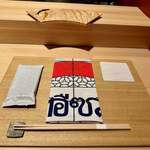


Otama3
3.40
I love unique flavors and enjoy both ethnic cuisine and sushi, so I really enjoyed the Tom Yum Goong-style miso soup. I even felt like having a second helping. Overall, though, I felt that the portions were a bit small, so I wouldn't mind if the prices went up a little for more volume. After all, I needed a bit more fuel to get through the remaining half of my workday. The taste was delicious, though! Thank you for the meal.
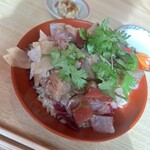
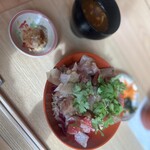
カレーおじさん\(^o^)/
4.00
I visited Sugihisa, a restaurant that fuses sushi and Thai cuisine, known for its "Hentai Sushi" and recognized as one of Tabelog's Top 100 Restaurants. This was my first visit since their relocation to Toranomon Hills, and I learned that they offer a course specifically focused on curry. It was absolutely amazing. The experience began with green curry chawanmushi (savory egg custard), and almost everything featured Thai curry flavors. There were green curry, jungle curry (gaeng pa), massaman curry, red curry, dry green curry, and vindaloo—everything except for vindaloo was a Thai curry.
The dry green curry is not traditionally authentic Thai cuisine but is the signature dish of the legendary restaurant "Imuya," where the chef trained. To be able to taste that dry green curry in the form of inari sushi here is already a rare treat, and then they go ahead and create curry sushi; it truly is genius (in a complimentary way).
The most outstanding dishes included buri (yellowtail) massaman with oboro (a type of egg), chicken avec geang pa, the sushi rice curry with tuna blood vinda, and squid grilled in a traditional fashion with red curry. While all the dishes were fantastic, those mentioned left a deep impression that I will never forget.
By the way, the regular Hentai Sushi can be enjoyed with a reservation. If you mention that you want to try this specific course, they might include it for you. The chef laughed and mentioned that the preparation for the squid grilled in a traditional style was too labor-intensive, so it might not be offered again, but aside from that, for anyone who loves sushi, Thai cuisine, or even just one of them, this unique culinary experience is certainly enjoyable!

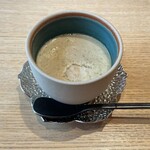
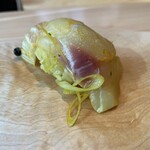
uranaisi
5.00
This event is themed around curry. The chef's sense of cooking and the logical way of combining flavors is truly genius. It's amazing how well they come up with new menu items. I believe this restaurant deserves more recognition in the community. However, rather than coming to eat sushi, come to experience something new. This is what you call innovative!
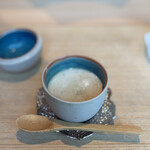
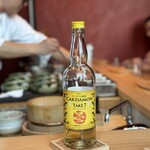
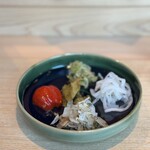
ドラノログ
3.70
Experience the fusion of traditional Japanese sushi and Thai cuisine at 【Sushi Sugahisa】… Enjoy an ethnic twist on sushi with Japanese ingredients reimagined with Thai spices and herbs… The omakase course changes with the seasons and is prepared by a skilled chef with experience in Thai cooking, right in front of you【Beverage】❶ KBT Kombucha Tea【Price】18,000 yen (including tax)【Thai Cuisine x Sushi Omakase Course】■ Botan Shrimp Miang Kham■ Shime Saba Spring Roll with Daikon and Carrot Namasu… Wrapped with perilla leaf in rice paper■ Kombu with Roe and Green Curry Chawanmushi■ Green Papaya and Ginger Gari■ Sushi❶ Tai with Lemon Soy Sauce❷ Makajiki with Passion Fruit, Sansho Pepper, and Black Pepper❸ Marinated Red Tuna with Cumin❹ Kohada with Yuzu Pepper❺ Buri with Thai Basil❻ Shima Aji with Cilantro Mayo❼ Ikura Don with Pineapple Seafood Sauce❽ Chutoro with Salad Dressing, Herbs, and Lime❾ Shrimp with Tom Yum Goong, blue rice cooked with shrimp broth and butterfly pea❶⓪ Uni Comparison: Thai Uni with Massaman Curry Flavor and Hokkaido Dungeness Uni with Tom Yum Goong Flavor❶❪ Anago charred on banana leaf with cinnamon flavor■ Inari Sushi■ Tuna Futomaki with Miang Kham■ Tom Yum Goong Miso Soup■ Tamagoyaki with Coconut Milk
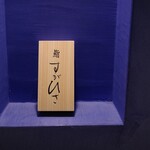
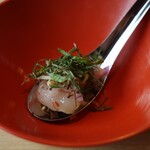
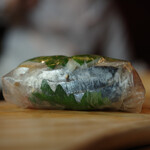
エベ0111
4.60
It's not exactly in the usual sushi genre, but I highly recommend it! I was taken to this restaurant, and while I had heard beforehand that it was sushi with a Thai twist, I was still surprised. Thai cuisine??? I was so excited about sushi that I forgot it was Thai food and went in thinking I was just going to eat regular sushi. But wow, what a surprise! Everything was Thai food × sushi. (Of course!) By the way, I was just okay with Thai food before, but now I’ve become a fan! Everything was amazing and incredibly delicious, so you have to go! The seasoning was fantastic, and you could really tell they put a lot of thought into it. There wasn't a single dish that was just "okay" - everything was delicious! Even the substitute for gari (pickled ginger) was so good that I can't even remember what it was! Most restaurants are nice to visit once, but I want to come back here over and over again. Highly recommend it! I'm so grateful to the person who told me about this place! ❤️

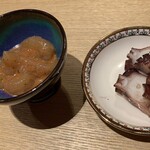
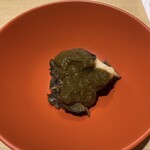
ラストエンペラーしもっつ
3.90
I visited Sushi Sugihisa located in Toranomon Hills. I’ve heard that the fusion of Thai flavors with sushi is amazing, so I was looking forward to it. The restaurant’s interior is so uniquely designed with red walls and an ethnic vibe that it almost doesn’t feel like a sushi place. The chef originally came from a Thai cuisine background and later started a sushi restaurant; it seems he initially offered traditional sushi. It was a special event for regular customers where he served unique dishes that received great feedback, which inspired him to develop this concept.
The menu features dishes full of Thai influence, including various sushi like shime saba, sea bream, mackerel, squid ink, kohada, marinated tuna, buri, ikura, and a uniquely shaped sea urchin dish made with coconut milk, as well as uni inari sushi. Looking at this, one might think it’s regular sushi, but every preparation reflects Thai techniques. If you’re expecting to enjoy traditional sushi, I suggest you manage your expectations and come with the mindset of enjoying Thai-style sushi instead. The flavors are undeniably delicious, and the chef is friendly and approachable. Thank you for the wonderful meal!
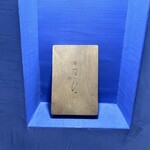

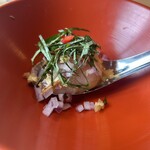
はなよりだんごおおお
3.30
Price: 3.1/5 Taste: 3.3/5 Atmosphere: 3.3/5
Date: 2024/10 Weekday, around 12:30 PM No reservation Wait time: none
I had no choice but to get the Thai-style chirashi (1,650 yen). The appetizers, seaweed salad and tom yum soup, were also Thai-style. I'm not quite sure about the dessert... maybe it was coconut-based? (laughs) According to the menu photos, the chirashi sushi was supposed to come with an egg yolk, but the chef forgot it? (I noticed when I looked at the photo later.) The taste of the chirashi was innovative, and I'm quite interested, but I was concerned that some of the fish ingredients weren't very fresh. I would like to visit again if I have the chance!
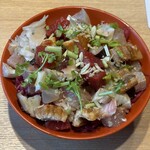
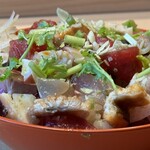
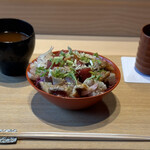
どら身
3.70
This restaurant is rumored to offer a unique fusion called "Thai Sushi," which incorporates Thai cuisine into sushi. It's quite rare in Japan! I was intrigued, so I thought it would be fun to share this experience with a friend who could understand and appreciate such a creative twist—hence, I brought along Dorami (laughs).
The entrance was a bit hard to find, located in the Toranomon Station Building. Ah, it makes sense that it's named after the station since it's directly connected! My companion works in Toranomon and knows the area well, and since there was unusual traffic from golf that day, we were able to push back our reservation by close to an hour and arrived just before 8 PM. To our surprise, the counter was completely reserved for just the two of us that night! Sorry for running late, though (sweat).
When this place was in Mizonokuchi, they only held this unique Thai-themed event once a month, which made reservations difficult. Now, we have a chance to enjoy this emerging space in Toranomon. As we chatted about that, we decided to go for a bottle of white wine. The selection was impressive, particularly the variety from Nordic regions! For our first bottle, we decided on an unusual Danish white (oops, forgot to take a picture). I can't recall the second one either, as I lost my notes, but the prices were reasonable, and it was nice to see a good selection of Nordic whites that pair well with the spices in the dishes!
- The first course was "Miang Kham: Sweet Shrimp with Betel Leaf." Although this is usually a snack wrapped in leaves, here the concept was flipped—we used what looked like shiso leaf, with a sauce underneath. The sauce really emphasized the Thai flavor!
- Next was "Aji (Horse Mackerel) Sushi with Rice Paper: This can change texture depending on moisture content and how long you leave the rice paper before eating it! The moist, chewy texture combined with the fresh, delicious aji was surprisingly good. The chef mentioned that while rice (sushi rice) is like rice paper, you shouldn’t compare this to what’s trending on Instagram! (laugh)
- "Low-Temperature Cooked Oysters": This was inspired by sauce typically used for Thai hot pot. I’ll refrain from commenting on the oyster's texture due to the cooking method (hushed laughter).
- "Green Curry with Kazunoko (Herring Roe) and Chawanmushi: Wow, this tasted like chawanmushi but with the essence of Pad Pong Kari (a type of Thai curry dish). It was fairly smooth, making it a great dish full of Thai flavor!
Next came a variety of side dishes packed with Thai aromas, such as ginger with green papaya and dill, and nuts flavored with green curry. Dishes like this truly made me want to enjoy some gin!
When the sushi arrived, I immediately noticed the arrangement of the nigiri. Unlike most sushi restaurants that place the nigiri directly in front of you, here they were slightly angled to suit the dominant hand of the diner. That’s a thoughtful detail that isn’t easily recognized, especially since I had previously mentioned being left-handed. Some places still can’t manage such small yet significant considerations.
- "Sea Bream with Cilantro, Mint, and Fish Sauce"
- "Shima Aji (Striped Jack) with Green Chili and Pepper"
- "Hokkigai (Surf Clam) with Salted Egg (mystified note here)"
- "Maguro (Tuna) Akami with Cumin"
- "Passionfruit with Shima Aji"
- "Thai Mint with Gapao (Basil) and Sawara (Spanish Mackerel)"
- "Buri (Yellowtail) and Back Fat"
- "Mid-fat Tuna with Chopped Fatty Tuna, Fish Sauce, Lemon, Salt, Mint"
- "Boiled Shrimp with a Tom Yum Style"
- "Sea Urchin from Nemuro"
- "Tom Kha Gai Inspired Sea Urchin"
- "Anago (Sea Eel) with Green Curry (without Coconut): Inari with Cilantro and Peanuts"
- "Tom Yum Gun with Shirako (Cod Milt): It seemed like red miso soup but tasted completely like tom yum kung."
For those tired of classic sushi, this place could be a refreshing change. However, even though the techniques of Thai cooking are solid and the sushi does its job pretty well, the fusion might occasionally feel a bit half-baked due to potential overshadowing of flavors.
Rather than just blending the two cuisines, it might be better to serve distinct Thai and sushi dishes alternately so that each can stand out on its own. While the fusion experience was generally enjoyable, I don’t think I’d want to just visit once—this restaurant had enough intrigue to entice me to return! Some dishes could very well stand alone purely as Thai dishes (laughs), and although I forgot to take pictures, they also offered thoughtfully curated original drinks to pair with the food.
Thank you for the meal! I hope they continue their efforts and thrive!

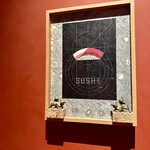
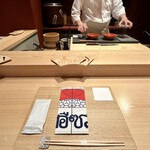
バーチー84208
3.70
I finally had the chance to visit the Thai restaurant that serves sushi at Toranomon Hills, which I had been curious about for a while! It was amazing how they incorporated elements of Thai cuisine into sushi, and it was incredibly delicious! It was a unique experience for me. I definitely want to visit again if I have the opportunity.
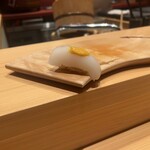
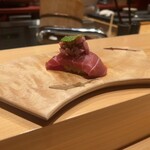
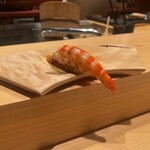
角煮don
3.80
I think it's a place where you can enjoy and savor inspiring dishes. Each item has a unique Thai culinary accent, keeping things interesting until the end. The flavors are wonderful and show the time and effort put into them. The chef's personality and years of skill are condensed into a deep and delicious sushi experience.
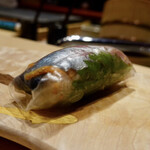
IKKO'S FILMS
4.00
Sushi Sugahisa, located in Toranomon Hills, Tokyo, has moved from Mizonokuchi in Kanagawa Prefecture. The restaurant operates only three days a month and fuses Thai cuisine with sushi, offering a unique concept called "Hentai Sushi." It is situated right next to Sushi Onikai. The restaurant features a compact L-shaped counter with only six seats.
The dishes are an evolution of the previously visited Hentai Sushi and showcase remarkable creativity. The raw spring rolls made with completely farmed "Karatsu Q Mackerel" challenge the notion of sushi by using rice paper. The green curry chawanmushi, with its crunchy texture from the kelp stuffed with roe, is exquisite. The inclusion of nuts in salads adds an unexpected yet captivating texture, reflecting the allure of Thai cuisine.
The approach involves breaking down existing Thai dishes and reimagining them within sushi. The sushi rice is a blend of red vinegar and rice vinegar, maintaining a traditional Japanese flavor, while the Thai elements are expressed through the toppings. This means the chef has to juggle the preparations for both sushi and Thai cuisine simultaneously, which is no small feat—after all, these extra steps are typically unnecessary.
For the lean cuts of fish, a base of cumin and soy sauce is used, and within it, there’s a hidden chickpea and cumin hummus. Some may find it hard to grasp this concept, but Chef Sugahisa adheres to a "not overdoing it" philosophy, ensuring that the added scents and flavors enhance the essence of the fish without overwhelming it.
One standout is the "Next Door Chutoro," featuring fatty tuna with negitoro and mint, inspired by the Thai salad called "Larb." The balance of the sweet richness of the chutoro with fragrant accents is delightful. The pairing of sweet shrimp and tom yum kung is a classic combination that works beautifully, and personally, I found the sweet shrimp to be the most fitting aspect of the meal.
The omakase course is priced at 18,000 yen, with a pairing option for 23,000 yen. To finish the meal, high-end tequila is also offered as a pairing. Chef Sugahisa emphasizes that while delicious food is essential, adding an element of entertainment creates a more enjoyable atmosphere.
He expresses a desire to emulate Japanese curry rice, which was originally a reimagining of Indian curry. Now, it's delightful to see Indian people enjoying CoCo Ichiban’s Japanese curry. This notion highlights that sushi culture isn't limited to traditional Edomae sushi. If so, one cannot deny the existence of California rolls either. With an open mindset, Chef Sugahisa is perhaps rethinking the culture of sushi itself.
Feel free to check out more restaurant recommendations on the blog! Also, visit the official blog of Ikkō here: https://ikkos-films.com/ and follow on Instagram: [IKKO'S FILMS](https://www.instagram.com/ikkos_films/).
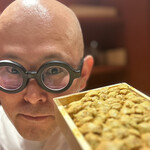
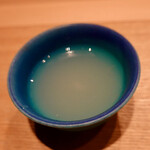
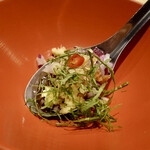
kamekame0815
3.50
I recently visited Sugahisa, known for its unique sushi, at the Toranomon Hills Station Tower for a girls' night out. I only learned about it after they moved, and I was really curious to try it. Despite train delays that caused us to be significantly late, they welcomed us warmly, which I truly appreciated. The sushi offered flavors that I've never experienced before—like a Thai twist! There were interesting dishes like seaweed with fish sauce, green curry chawanmushi, and maguro sushi with tom yum paste instead of wasabi. It was a great experience!
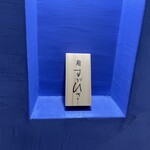

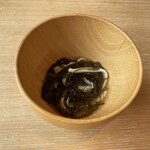
kaoriiina210210
4.00
I had always wanted to check out "Hentai Sushi" at its previous location near my workplace. It's now moved to Toranomon Hills, which is a bit farther away, but I'm happy they have started offering reasonably priced lunch menus. I wonder what the fusion of Thai cuisine and sushi would be like? After reading everyone's comments, I headed to the restaurant. When I got to the door, I thought, "Is this really the right door? Can I enter?" Just then, the chef peeked out, and I felt relieved. The lunch menu had only one option: chirashi sushi. It came with side dishes, miso soup, and dessert (which I forgot to take a picture of). What I could identify were the som tam-style pickled ginger, tom yum miso soup, curry-flavored rolled omelet, and I think the egg yolk might have been marinated in nam pla. I regret not asking the chef about everything while I was enjoying my meal. The dessert they called a rolled omelet turned out to be a pudding (^ ^) and it was delicious! The ingredients might change with the seasons. The restaurant has six seats, so I think I can easily go back by myself whenever I feel like it!
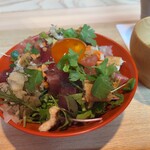
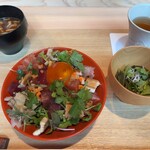
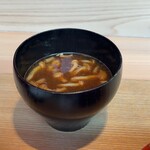

chengdu4000
3.00
I had lunch at Toranomon Hills Station Tower and tried their ethnic seafood rice bowl. It had a Thai-like flavor... Hmm, I can somewhat understand it if it was served as a seafood salad at Monsoon Cafe instead of a rice bowl, but I'm not sure about the compatibility with the rice. Also, adding spices to the miso soup... I just couldn't wrap my head around it.
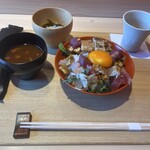
お肉モンスター
4.10
The sushi restaurant connected to Toranomon Hills Station is famous for its unique sushi offerings. It is located on the fourth floor, which has many shops, but only "Onikai" is listed on the floor map as offering sushi, so be cautious. It's right next to Onikai, which I initially considered for a private room, but then I found out that "Sugihisa" was also operating in the area. From the outside, it looks like the same restaurant, but it is entirely different. The entrance on the left leads to Sugihisa.
The interior is a compact L-shaped space with just six seats, providing a nice view of Tokyo Tower. The course meal is priced at 18,000 yen, consisting of three appetizers, twelve pieces of sushi, a small rice bowl, rolls, soup, and a sweet omelet. This sushi experience is completely different from traditional Edomae sushi—it's almost Thai cuisine. The rice and seasonings vary from one dish to another, and many of the dishes have strong Thai influences, including some that pack a bit of heat.
One standout was the Thai sea urchin, which resembled a beautifully crafted Massaman curry, presented in a wooden box, cleverly mimicking the appearance of sea urchin. The creativity in the presentation is impressive. It's definitely a different take on sushi, as it feels more like a visit to a Thai restaurant rather than a sushi place. I personally enjoyed the flavors of acidity, spiciness, and Thai spices, making it a fascinating experience for me. The head chef is undoubtedly entertaining as well. It's truly unique!
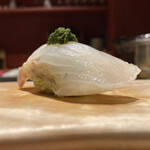
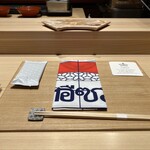
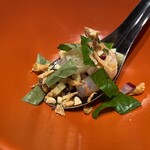
田原寿彦
4.00
A unique restaurant that combines Thai cuisine with sushi, something that seems like it should exist but doesn’t. Every menu item incorporates elements of Thai flavors, hinting at a future where sushi restaurants around the world blend with various international cuisines and adapt accordingly. The personable head chef of this Thai-inspired sushi place is fantastic, and there’s no reason this restaurant shouldn’t be a hit. I highly recommend trying it out, but it might not be suitable for those who don’t like Thai food! Interestingly, there’s a sushi restaurant next door, but it doesn’t even feel like a competitor; the concept here transcends traditional sushi!
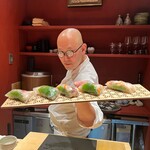

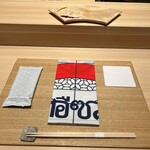
buska
3.60
I was curious about the collaboration between Thai cuisine and sushi, so I decided to check it out. It took me a while to find the food location in the mall building, so I aimed to arrive 15 minutes early. As expected, I got lost and arrived just 2 minutes before my reservation, which turned out to be a good decision. Be careful, as the name isn't listed on the floor guide; it was labeled as "Hentai Sushi," so I was a bit anxious about what kind of chef I would encounter, but fortunately, he was a perfectly normal gentleman. His language was polite, he explained the ingredients well, and provided a thorough historical background. I really want to support him from the shadows.
The Thai appetizers came out one after another, offering a variety of flavors—sweet, salty, and spicy.
- Firefly squid with Tao Siow (Thai miso), lime, lemongrass, and ginger.
- Octopus cooked in a sweet sauce.
- Mackerel in spring rolls with pickled salad.
- Green curry and steamed custard with sea bream milt.
- Whalemeat yukhoe marinated in egg yolk and fish sauce.
- Green papaya and ginger with dill.
- Matsukawa flounder with cilantro, chili, mint, lime, and fish sauce—well-balanced.
- Cuttlefish with salted duck egg yolk—rich and smooth.
- Swordfish with mango and green chili—creamy.
- Sea clam with cilantro and yogurt.
- Lean tuna with cumin.
- Black rockfish with fish sauce and sweet herbs.
- Kohada with Thai chili, lime, and salt.
- Medium fatty tuna—love it the Totoro way, with onion, Thai mint, and roasted sticky rice.
- Sweet shrimp tom yum goong.
- Fake sea urchin steamed in curry with egg, coconut milk, lime, and fish sauce—rich and mellow.
- Sea urchin mini bowl with coconut milk.
- Anago cooked in banana leaves with cinnamon.
- Inari sushi with cilantro and green curry with crispy pork skin.
For the soup, there was tom yum ramen, and the egg dish was made with coconut milk and mango. Various seasonings and spices were used thoughtfully, but I felt it was a bit challenging to appreciate the sushi rice and toppings fully. Overall, the experience leaned more towards Thai cuisine than sushi. However, the medium fatty tuna, inari sushi, and tom yum ramen were exceptional that day. I think I’ll revisit for a change of pace when I grow tired of traditional Japanese sushi.
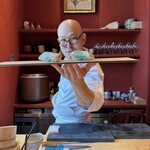

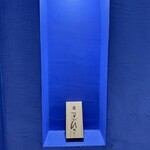
よく食べる子/東京グルメ
3.00
It was a new genre! It was interesting!! It's neither Thai food nor sushi... completely a new genre of cuisine!……………………………………………………………………………………………⭐️5⭐️ I want to go often. I love it so much that I don't want to tell anyone about it. ⭐️4⭐️ If someone asks for a recommended restaurant, I would introduce it. ⭐️3⭐️ I'm thinking about going again~ ⭐️2⭐️ Hmm, if possible, I’d prefer to go to a different restaurant. ⭐️1⭐️ Personally, I do not recommend it.♀️ Tabelog: A food lover / Tokyo Gourmet.
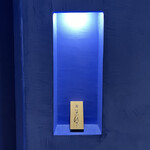
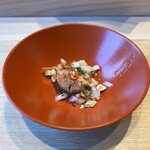
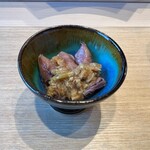
sumiccho
4.00
I enjoyed delicious sushi in Mizonokuchi and learned that the restaurant had moved to Toranomon, so I decided to visit. I was pleasantly surprised in a good way. The atmosphere of the restaurant and the flavors were unlike anything I had experienced before. Although it was sushi, it wasn't just traditional Edomae sushi; I felt like I was introduced to the joys and deliciousness of sushi in a whole new way. The Tom Yum Kung set was also rich in flavor and paired wonderfully with the sushi. The location is lovely, with a view of Tokyo Tower from the window. Lunch is reasonably priced, and I would love to try it for dinner as well.

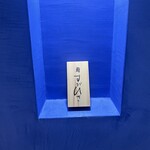
ジェームズオオクボ
4.30
Sushi Sugahisa @ Toranomon Hills Station Tower - The potential of "Hentai Sushi" was found next to Kuhon Shrine in Mizonokuchi at "Hentai Sushi Sugahisa." This sushi shop, run by a member named Suga, held events 2-3 times a month that became popular among foodies. Due to its rising popularity, it has now opened as a permanent establishment at Toranomon Hills Station Tower. On a certain day during Golden Week, I visited to cover the potential of "Hentai Sushi" for "Shihōyoshi Tsūshin." The meal consists of three appetizers and ten sushi pieces, priced at a total of 18,000 yen including tax. Today, I opted for a non-alcoholic pairing.
The dishes included:
- Sweet shrimp with Miang Khum (a Thai appetizer).
- Kombucha.
- Saba (mackerel) served as fresh spring rolls with stick vegetables and a lovely tang.
- Tai's white roe with green curry steam egg, refreshingly non-sour.
- A dish using green papaya and ginger from Asano-san in Kochi, who grows green papaya.
- Shredded flat shell clam with fuki miso.
- Roe of flatfish with a non-spicy seafood sauce featuring cilantro, lime, fish sauce, and mint paste.
- White squid with kai kem (salted egg, fish sauce, and shrimp paste).
- Marlin with mango and green chili, carrying a mild heat.
- Lean tuna with homemade nam prick (chili water).
- Spanish mackerel prepared with a paste of the zest of kaffir lime and basil, reminiscent of Thai basil stir-fry.
The non-alcoholic pairing included watermelon juice with lime.
Next was horse mackerel with green chili, lime, and bell pepper, capturing the fresh aroma of bell pepper, paired with a salad dressing made with various herbs and lime for a crunchy texture, served over sticky rice.
Continuing with blue shrimp, there was Tom Yum Kung rice made with a broth from the shrimp and butterfly pea flower, creating a beautiful blue rice.
The meal also featured a comparison of sea urchins—“Thai urchin” and a type from Hamana, complemented by herbal tea.
One of the highlights was a dish resembling Tom Ka Gai (chicken coconut soup) but using sea urchin, with grilled eel wrapped in banana leaves, served with a cinnamon-seasoned sauce.
The meal concluded with a thick roll made with Miang Khum and a rich soup that possibly was Tom Yum Kung.
Don’t forget to order the signature “inari” either as an extra dish or as a takeaway. (I forgot to do so.)
When I commented that the name "Sushi Sugahisa" is somewhat misleading, Suga mentioned that they applied for the name "Hentai Sushi Sugahisa," but it didn’t get approved, which seems pretty rigid. While I don’t want to give away too much, it remains an extraordinary sushi restaurant. Many attendees at the events were passionate about Thai cuisine and stylish, making this a place I highly recommend for those who enjoy Thai food.
Sushi Sugahisa
Address: 4F Toranomon Hills Station Tower, 2-7 Toranomon, Minato-ku, Tokyo 105-0001
*Please refer here for directions to the restaurant.*
*Reservations can be made online.*
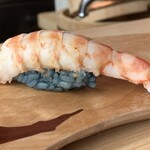
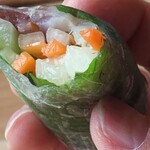

Email Login